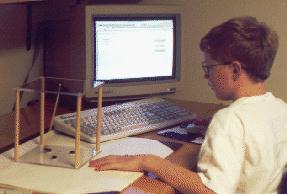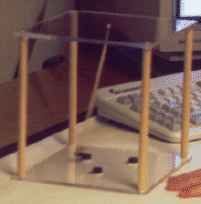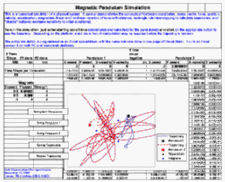Math Exploration Quilt
Note: This site is a historical archive. The Math Exploration
Quilt is currently "mothballed" and has
not been modified or extended since 1/6/1997. The slides from a
presentation at NCCE'96 can be found here.
Innovative Mathematics Education
At Hanford School
The Math Exploration Quilt is a computerized environment in which students learn concepts and applications of advanced mathematics through hands-on investigation. Interactive software modules programmed in Microsoft Excel, Visual Basic, and Netscape Navigator are provided in an "open" form that students are encouraged to explore and modify. The software is portable between PC's and Macintoshes, and is designed to run with or without Internet support. The Math Exploration Quilt is still in an early stage of development. However, the available materials do successfully demonstrate many of the concepts that we started with, so we are making them publicly available in the hope that they are helpful to others with similar goals.
This page, and all other Math Exploration Quilt pages, are designed to work with Netscape Navigator. Use with other browsers is untested.
The Math Exploration Quilt is an experimental mathematics education program started in fall 1995 as a collaborative effort between Hanford Secondary School and volunteers at the Pacific Northwest National Laboratory (PNNL) in Richland, WA. Initial funding for the Math Exploration Quilt is being provided by grants from the Washington Software Foundation (WSF) and Microsoft Corporation. Additional support is provided by the U.S. Department of Energy through the PNL computing infrastructure. Thanks are owed to many individuals for their efforts in getting the Math Exploration Quilt started.
Note: prior to 01/06/1997, the Math Exploration Quilt was called "Math Exploratorium". The name was changed at the request of the San Francisco Exploratorium, for whom "Exploratorium", "Exploranet", "Explorabook", and "Exploracenter" are registered trademarks.
Vision

A Hanford student learns math, physics, and programming while having fun with the Magnetic Pendulum Workbook (programmed in Microsoft Excel).
Vision Statement
The Math Exploration Quilt will be a computerized environment that empowers and encourages students to learn advanced mathematics and modern software that can be applied to everyday life.To illustrate our terms, an example of "advanced mathematics" (at the middle school level) is the concept of exponential growth as it relates to compound interest and population explosions, and an example of "modern software" is a spreadsheet program with integrated graphics, a numerical solver/optimizer module, and an embedded programming language like Visual Basic.
Goals
The Math Exploration Quilt will accomplish several goals:- First, it
will help students to develop an intuitive understanding of
mathematical concepts, by providing them with a "hands-on"
experimental environment in which they can explore the concepts while
the computer takes care of the otherwise distracting and irrelevant
details.
- Second, it will help students learn to exploit modern
software, by giving them an assortment of predefined practical
problems and the corresponding computerized solutions, and allowing
them to explore the solutions to understand how they work.
- Third, it will expose particularly advanced students to the process of software development, by allowing them to extend the Exploration Quilt by refining or adding new problems, solutions, and mathematical concepts.
Reproducible Environment
The Math Exploration Quilt will be a reproducible environment. That is, instead of being dependent on the personalities and teaching skills of individual on-site mentors, the Exploration Quilt will be packaged as a collection of software and associated display and study materials that can be copied for use anywhere there is an adequate complement of commonly available computer equipment.Wide Range of Mathematics and Applications
In the long term, the Math Exploration Quilt will include modules addressing a wide range of topics in mathematics and applications, including such areas as probability, the physical and biological sciences, and consumer economics (e.g. time payment plans). These computerized modules and associated curriculum materials will be made generally available to the secondary school education community. In the short term, distribution will be limited to Hanford Secondary School, and development of modules will be driven by interests of the Exploration Quilt's teachers and students.An Example -- the "Magnetic Pendulum" Module
An advanced example of these ideas is provided by the "Magnetic Pendulum" module.
Fascinating Physics
The magnetic pendulum is a physical toy that consists of a rigid pendulum, with a magnet glued to its bottom end, swinging over a base on which several other magnets have been placed. The toy's behavior is both fascinating and nonintuitive -- you don't know what to expect, but whatever it does is not anything you would have expected. Most people can't keep their hands off it.Numerical Simulation
The corresponding Math Exploration Quilt module centers around a Magnetic Pendulum Workbook that performs a numerical simulation of the toy. The workbook is programmed in Microsoft Excel. It contains a spreadsheet plus a collection of Visual Basic code for control, graphics, and numerical simulation. All of the Visual Basic code is fully accessible to the student and can be explored at the student's discretion. At the same time, the Excel workbook is quite approachable -- it can be operated by a simple interface that uses just buttons and spreadsheet cell entries, and provides graphical display of output.Lots to Learn!
Taken as a whole, the Magnetic Pendulum module includes an unexpectedly rich variety of physics, mathematics, and programming. In physics, it touches on the concepts of mass, force, acceleration, velocity, and linear/nonlinear variation of force with distance. From mathematics, it uses the Pythagorean theorem, algebra, vector arithmetic, and explicit time-stepping (rectangle rule integration) to compute the trajectory. In programming, it demonstrates a wide variety of Visual Basic techniques, including modular programming, control structures, and several ways for Visual Basic code to interact with spreadsheet cells and functions."Chaos" On a Desktop
An interesting aspect to the numerical simulation is that it clearly demonstrates that the pendulum system is "chaotic". This means that the path of the pendulum is extremely sensitive to small changes in position or velocity, with any little change growing exponentially (multiplying) over time. In the example, two pendulums are started less than one-millionth of an inch apart, yet their trajectories soon diverge until they bear no resemblance to each other. If you make the starting difference smaller, then divergence takes a little longer, but it still happens. In fact, complete divergence still occurs quickly even when the starting points are separated by as little as one millionth of the width of an atom! This explains the observation that no matter how hard you try, you simply cannot get the physical pendulum to trace out the same path twice. (This behavior is shared by most balls that bounce freely, from billiards to pinballs to basketballs on the rim.)Playing With The Workbook
The Magnetic Pendulum workbook runs in Excel 5.0 (or higher) on both PC and Macintosh platforms. You can download a copy of it to play with.The Math Exploration Quilt Framework
New Territory
The Math Exploration Quilt is an experimental program based on new ideas and new tools. Quite frankly, we don't know exactly where it will end up, or how it will get there. (The entire project is analogous to the magnetic pendulum in this regard.)Whatever else it does, the Exploration Quilt will certainly provide a unique hands-on opportunity for students to see and "feel" how advanced mathematics techniques are used to solve problems. Will this be good? Well, we're not sure, but we think it will be or we wouldn't be doing it!
Building on Common Tools
Our intention is to use general purpose and commonly accessible software tools to build the Math Exploration Quilt. We are using Microsoft Excel and its embedded programming language (Visual Basic for Applications) to construct interactive applications such as the Magnetic Pendulum Workbook. We are also using Netscape Navigator to provide hypermedia documents that help students to pick interesting modules, suggest exercises to do with them, provide background explanation, and collect feedback to guide further development. (The Exploration Quilt does not require Internet access, however -- all of the Netscape files are local to the school's computers. We want to keep the Exploration Quilt insulated from Internet issues for a while.)Support for Teachers
A big part of making the Math Exploration Quilt a success will be to attract supporters and collaborators from a wide range of people -- students, teachers, and administrators. Many of these people will have had little or no prior exposure to the software that the Exploration Quilt will be built on, so they will need some encouragement and support to get started.To accomplish this, particularly for teachers involved in developing the Math Exploration Quilt, we are providing a class focusing on innovative use of Excel and other products as used by the Math Exploration Quilt. Some financial support (from the WSF grant) is being provided for teachers to take this class, and Hanford School has arranged with a Washington college to grant Continuing Education credits for teachers taking it.
To Learn More
Some sample modules and Excel workbooks can be accessed through the Welcome to the Math Exploration Quilt!" student's greeting screen and through links in the list of suggested topics. To ask other questions, volunteer your efforts, suggest sources of support, or provide other input, please contact:-
- Rik Littlefield
- Battelle/PNL, MS K7-15
- P.O.Box 999
- Richland, WA 99352
- email: rj_littlefield@pnl.gov
- phone: 509-375-3927 (work) or 509-375-3493 (home)
The Math Exploration Quilt is Rik's brainchild and at the moment he's the central force (and main volunteer) in making it happen. He'd love to hear from you.
The Math Exploration Quilt is mothballed -- last actual modification 1/6/1997.
